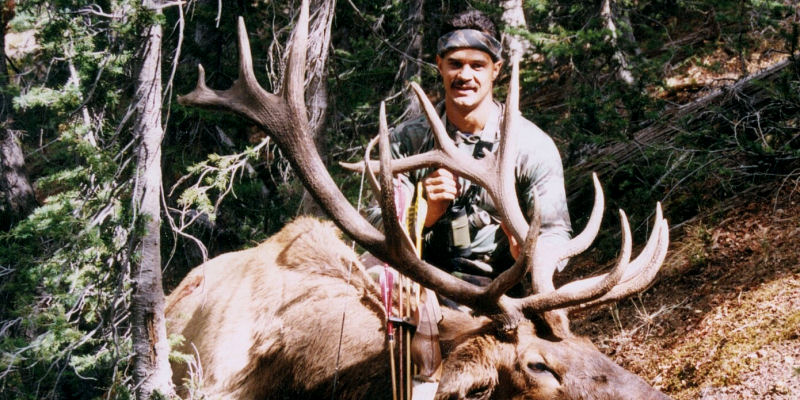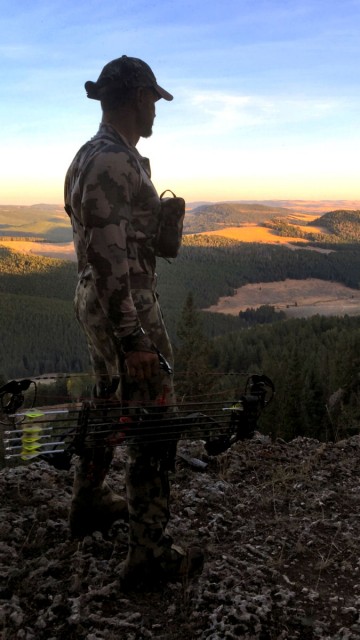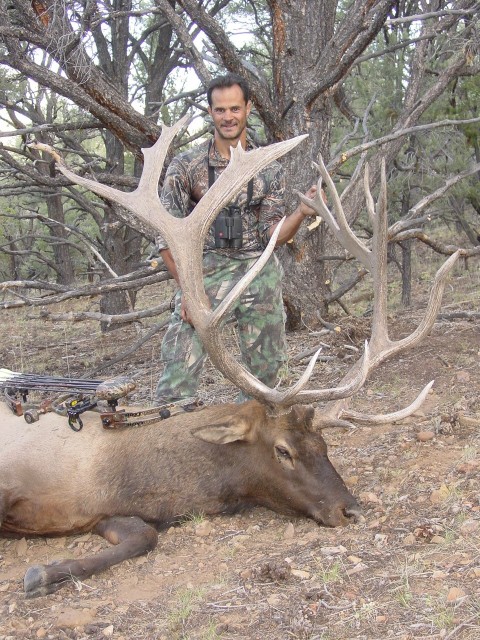Solo Elk Hunting Tactics


As the bull came screaming down the mountain, the “cow, calf and bull” that were standing in my shoes were shaking uncontrollably! He stopped 30 yards away, bugled, chuckled, and peed all over himself (or was that me?). As he turned to walk away, I realized that I couldn’t have shot if I had wanted to. I was so jacked-up, my arrow was dancing on my rest like a Mexican jumping bean!
This was my very first elk hunt, and my very first encounter with a screaming bull. That hunt lit a fire in my soul that still burns with intensity to this day, and I’ll never forget it!
The bull began moving back up the hill to get the wind in his favor, and somehow I gathered together enough common sense to call again. I crawled ahead another 40 yards and set up in a better position. I had no idea what I was doing, but my instincts told me I needed to move ahead of where I had just called from. Just as I got setup in the new location, the bull came smoking back down the hill…
 Looking back on my very first elk hunt in 1988, I am confident that the best thing I ever did was learn to hunt, call, and kill elk by myself. My friends would always make comments like, “You’re going to hunt elk in the mountains by yourself? That’s crazy!” However, my desire to call and bowhunt elk was so much stronger than the fear of being alone in the mountains. Every time I did it, I couldn’t wait to do it again!
Looking back on my very first elk hunt in 1988, I am confident that the best thing I ever did was learn to hunt, call, and kill elk by myself. My friends would always make comments like, “You’re going to hunt elk in the mountains by yourself? That’s crazy!” However, my desire to call and bowhunt elk was so much stronger than the fear of being alone in the mountains. Every time I did it, I couldn’t wait to do it again!
The only teachers/mentors I had back then were two VHS videos that Larry D. Jones, Dwight Schuh, and Pete Shepley had produced. Trust me, I wore those videos out trying to learn to hunt elk.
I didn’t have the resources of YouTube, Facebook, Google Earth, Podcasts, bow hunting forums, and GPS units to learn from and navigate with. Back then, I relied on my 7.5-minute topo maps and compass. Coincidently, sometimes I still do today.
For me, elk hunting is all about calling and the heart-pounding adrenaline rush I get from close encounters with rut-crazed bulls. There are certainly other ways to hunt elk – treestands, ground blinds, still-hunting, spot and stalking, etc. In fact, I would say that in general, the bigger bulls are killed by stalking more than calling. But for me, the up-close encounters with bugling bulls are what I live for.
Learning to call well enough to call-in elk wasn’t necessarily all that difficult. Learning how to close the deal once the adrenalin was flowing, the bulls were screaming, and your heart was pounding uncontrollably, was. When should I move? Or, should I just stay put? Will the bull respond and come in to my calls? All these questions – and many more – ran through my mind on a continual basis. Fortunately, I in the past 27 years of elk hunting, I’ve found a formula that has worked well for me.
My elk calling sequence is usually pretty consistent – I give two high-pitched calf calls followed by a cow call. Then, depending on the bull’s response, I normally do one of three things:
1. If the bull is fired up and bugles close by, I’ll cut him off mid-bugle and absolutely walk all over him with aggression. At the same time, I’ll move 20-40 yards as quickly and quietly in his direction (depending on the situation and the ground cover). I’ll find a good opening, set up, and not make another sound. Chances are, he’ll be on his way, and you’d better be ready!!
There have been times that my aggression has catapulted me right into the bull and busted him out, but the majority of the time, this tactic has payed huge dividends.
2. If the bull responds from a long distance, I won’t make another sound. I’ll check the wind, and then I’m off as quickly as my conditioning will take me in his direction. I try to get within 100 yards, preferably 75 yards or so, and do the same calf/cow calling sequence again. If the bull bugles, I pick up at Step 1, and CUT HIM OFF. Again, I’ll move another 20-40 towards him from my last call and set up.
3. If there’s no response from the initial calling sequence, I’ll bugle several times, and listen, almost holding my breath listening for the slightest elk sounds. I’ll move a short distance and do it again. I call A LOT and cover a lot of country looking for a response.
 When hunting/calling alone, it’s important to move forward each time you call. Bulls have an uncanny ability to pinpoint the location of your last sound, whether it’s a call you made or a stick you broke. Moving forward that last 20 to 40 yards without making another sound gets you away from the point the bull is focused on when he comes in, similar to having a caller back behind you. It takes much more stealth and a fast, well-executed move, but it is often the difference between closing the deal and ending up with tag soup.
When hunting/calling alone, it’s important to move forward each time you call. Bulls have an uncanny ability to pinpoint the location of your last sound, whether it’s a call you made or a stick you broke. Moving forward that last 20 to 40 yards without making another sound gets you away from the point the bull is focused on when he comes in, similar to having a caller back behind you. It takes much more stealth and a fast, well-executed move, but it is often the difference between closing the deal and ending up with tag soup.
The lessons I learned from my very first elk hunt laid the foundation I use to this day. Don’t be afraid to be aggressive. Don’t be afraid to call and move closer. It’s an all-too-common feeling to have a bull hangs up 70 yards out. If you’re hunting alone, when he hangs up, you’re pinned down and often end up watching him walk away.
And while I hunt alone much of the time, I do have an elk hunting partner who has also honed his solo elk hunting skills. When Drake Atwood and I have the opportunity to hunt together, our solo-style of elk calling makes us even better as a team.
……This time, when the bull came smoking back down the hill, he stopped with fire in his eyes and began destroying a small pine tree 40 yards away. After a few seconds, he threw his head in rage, looking for the bugling intruder. He moved closer and broadside 30 yards away, and when his head went behind another small pine, I came to full draw. I settled my pin behind his front shoulder and relaxed my fingers. Instantly, the arrow was on its way! If I hadn’t moved that last 40 yards, there is no doubt that I wouldn’t be sharing this story with you today.
27 years later, each time I look at that bull on my wall, I’m so grateful for the lessons I learned on that first self-guided elk hunt. The path God laid before me to pursue such an incredible majestic animal each fall is a true blessing.

